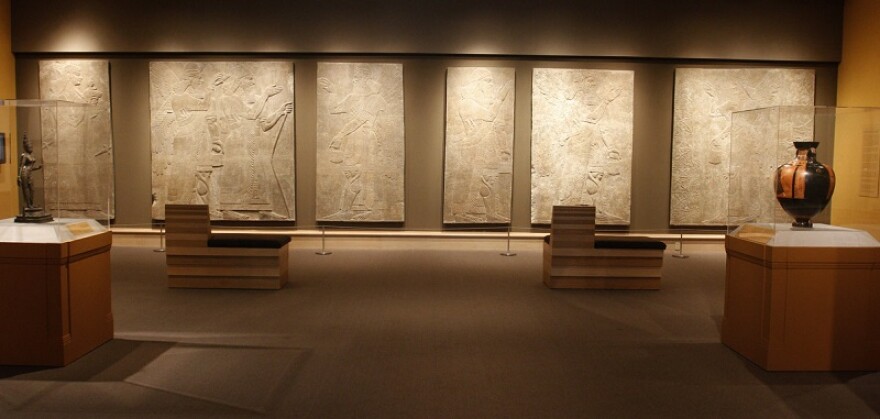As news breaks about the possible destruction of cultural artifacts by the Islamic State — also known as ISIS — a Dartmouth College scholar is outraged. The college owns six monumental stone relief panels from Nimrud, Iraq, south of Mosul, where vandals claim to have been bulldozing sacred sites. While the videos released by the militant group cannot be verified, it’s clear that rare antiquities are ISIS targets.

But several have been safely housed at the Hood Museum at Dartmouth College for over 160 years.
On a huge wall just inside the entrance, a row of larger-than-life figures carved into gypsum stone, most with curly beards and sandaled feet, seem to walk from left to right in single file. Susan Ackerman, a religion professor at Dartmouth, gazes at the regal parade, and tries not to cry.
“It’s devastating to have to be witness to what’s going on in Iraq. It’s just devastating, and to be this tangibly close to those Iraqi artifacts and to be able to see and know and feel what’s gone is heartbreaking,” Ackerman says.
"To be this tangibly close to those Iraqi artifacts and to be able to see and know and feel what's gone is heartbreaking." - Susan Ackerman, Dartmouth religion professor
The stone reliefs decorated the rooms of the palace of King Ashurnasirpal II, of ancient Assyria. In panel two, the handsome king is followed by a winged servant holding, in one hand, a bucket of pollen, and, in the other, part of a date palm — one of the kingdom’s most fertile crops.
https://www.youtube.com/watch?v=rozI22zQaAQ&feature=youtu.be
Hear Susan Ackerman describe the reliefs. Photos by Herb Swanson.
“What you are seeing here when he touches the date palm spathe to the head of the king is that he’s essentially saying, 'The king represents the Tree of Life for Assyria, the king represents fertility for Assyria, it is from the king that all fertility, all blessing, all bounty come,'” Ackerman explains.
Blocks of tiny script, in cuneiform, scroll horizontally across the panels. Ackerman is the only person at Dartmouth who can read this wedge-shaped writing system common to Mesopotamia. This text, she says, repeatedly extols a then-powerful ruler.

“I am Ashurnasirpal the Second, the great king, the king of the four corners, the king who conquered the world and so on and so on and so forth,” she translates.
The panels were brought to Dartmouth by Austin Wright, class of 1830, who acquired them with help from Sir Henry Rawlinson, a representative of the British empire in Baghdad. Wright was a Christian missionary. Ancient Assyria, however, was not a Christian culture. It was polytheistic. Professor Ackerman says, to ISIS militants, any religious symbols amount to heresy. But she says the vandals are hypocritical.
“ISIS destroys images like this but simultaneously there are widespread and, I think, accurate, reports that ISIS has been systematically engaged in projects of looting archeological sites and of taking smaller objects from museums and selling them on the black market as a way of financing their operations,” says Ackerman.
These days, Ackerman says, removing such artifacts from their country of origin would not be considered ethical. But in the 19th century, when parts of the Nimrud palace were dismantled and acquired by a number of American colleges, including Dartmouth, it was a more accepted practice. In this case, the rescue turns out to have been fortunate. And the ancient carvings are priceless. Ackerman says she knows of one auction where just the broken, bottom half of a panel from another collection sold for $14 million. In contrast, Dartmouth’s six pieces appear to be in nearly mint condition.






